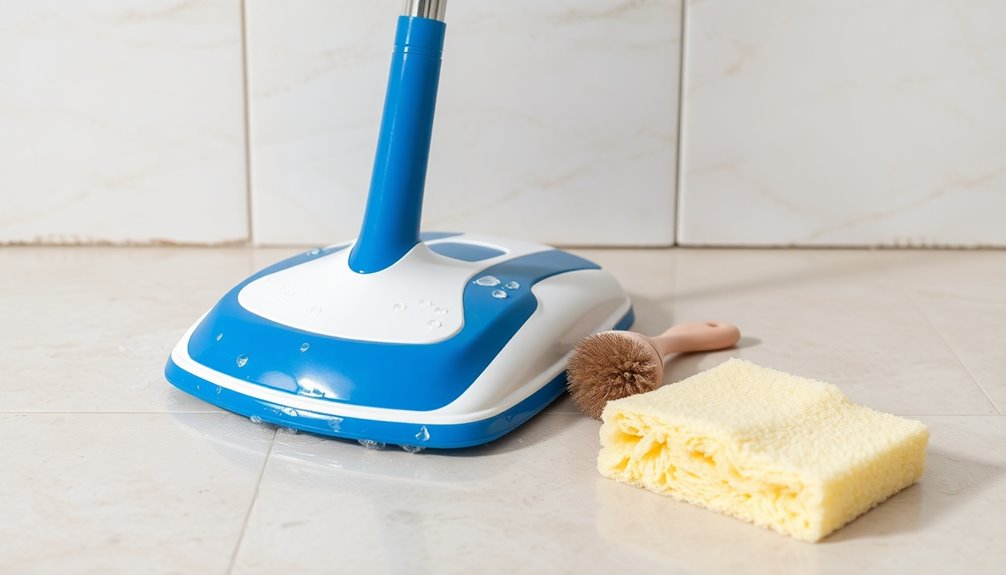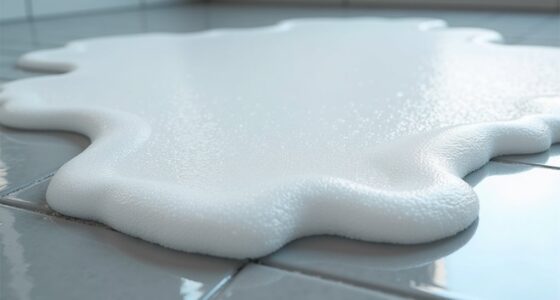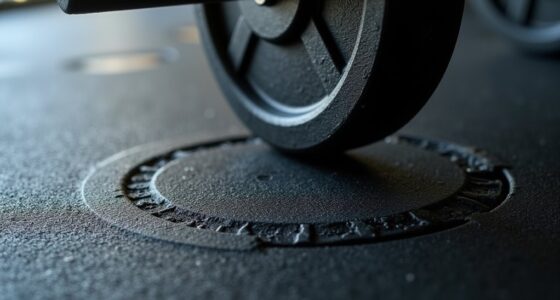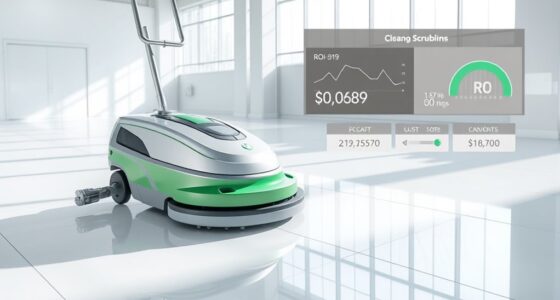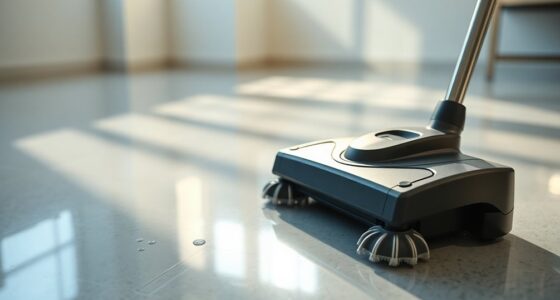To clean a floor scrubber, empty and rinse the recovery tank after each use to prevent odors and sludge. Don't forget to clean the solution tank thoroughly to remove leftover cleaning solutions. Regularly inspect the debris tray to avoid blockages, and ensure the squeegee assembly is wiped down for even water distribution. Lastly, maintain your brushes and pads by cleaning them frequently to ensure optimal performance. Keep going to discover more maintenance tips!
Key Takeaways
- Empty and clean the recovery tank after each use to prevent sludge buildup and odors.
- Rinse the solution tank thoroughly to avoid chemical buildup and ensure optimal performance.
- Remove and clean the squeegee assembly to maintain even water distribution and avoid floor streaking.
- Regularly inspect and clean the debris tray to prevent blockages in the drainage system.
- Maintain brushes and pads by cleaning them frequently to extend their lifespan and improve cleaning efficiency.
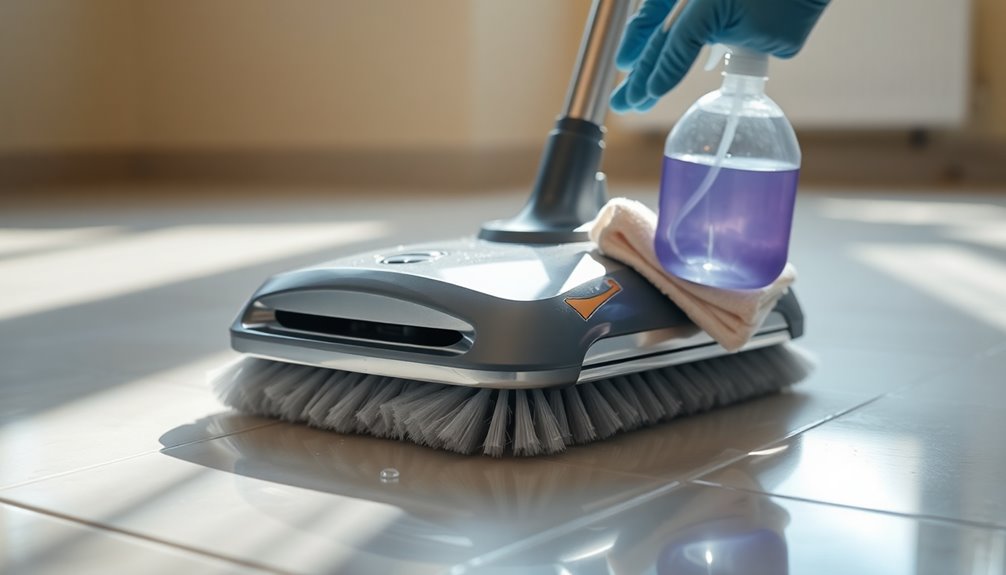
Cleaning a floor scrubber is essential for keeping it running smoothly and ensuring effective performance. After each use, you should empty and clean the recovery tank. This step is crucial to prevent sludge buildup and unpleasant odors that can hinder the machine's efficiency. Simply rinse out the tank with clean water, making sure to eliminate any residue that could affect future cleaning sessions.
Next, turn your attention to the solution tank. It's important to rinse this thoroughly to get rid of any leftover cleaning solutions. If you neglect this step, you risk chemical buildup, which can clog the system. A clogged solution tank negatively impacts your cleaning performance, making it harder to achieve optimal cleaning results.
Don't forget about the squeegee assembly! After every use, you should remove and clean it to ensure even water distribution during operation. A clean squeegee prevents streaking on the floor, preserving the quality of your work. Wipe down the blades with a damp cloth to remove any dirt or residue that might've accumulated.
Also, regularly check and clean the debris tray. This component plays a vital role in preventing larger debris from entering the drainage system. If it gets blocked, it can cause significant problems for your floor scrubber. Make it a habit to inspect and clear this tray to keep everything running smoothly.
In addition to these components, you'll want to maintain a consistent cleaning schedule for the brushes and pads. These are crucial for achieving optimal cleaning efficiency. Over time, dirt can accumulate on them, which decreases their effectiveness. Frequent cleaning ensures that your scrubbing tools are always ready for action, helping to extend the lifespan of your floor scrubber.
Incorporating these maintenance procedures into your routine ensures that your floor scrubber remains in top condition. By taking a little time after each use to clean the recovery tank, solution tank, squeegee assembly, and debris tray, you can significantly enhance your machine's performance.
Regular maintenance of brushes and pads further supports optimal cleaning, making your job easier and your results better. With these practices, you'll notice a marked improvement in your floor scrubber's efficiency and longevity.
Frequently Asked Questions
How Do You Clean Scrubbers?
To clean scrubbers effectively, you need to start by emptying and rinsing their tanks after every use.
Don't forget to clear out the debris tray to avoid clogs.
Rinse the squeegee assembly to prevent damage and ensure it works well.
Remove any debris from the pad driver or brush, giving them a good rinse.
Lastly, keep an eye on the battery water levels and add distilled water as needed for optimal performance.
What Is the Life Expectancy of a Floor Scrubber?
You might think floor scrubbers don't last long, but they can actually serve you well for 5 to 10 years, depending on how you use and maintain them.
Regular upkeep, like cleaning tanks and replacing worn parts, is key to maximizing their lifespan.
If you're using an industrial-grade model, you could see it last even longer—up to 10 years!
Just remember, proper battery care can also make a big difference in longevity.
How to Clean Your Foot Scrubber?
To clean your foot scrubber, start by rinsing it thoroughly with clean water to remove any dirt.
Remove the brush or pad and rinse it under running water, ensuring all residue is washed away.
Check the squeegee blade for wear and wipe it with a damp cloth.
After use, drain and rinse the tanks to prevent odors.
Store the cleaned parts in a dry area and let them air dry completely before reassembling.
Can You Put Bleach in a Floor Scrubber Machine?
Imagine pouring a potion into a delicate machine, hoping for magic but inviting disaster instead.
You can't put bleach in a floor scrubber; it's like throwing sand in a clock's gears. It can ruin internal components, damage seals, and even void your warranty.
Instead, reach for cleaning solutions that the manufacturer recommends. By using those, you'll keep your scrubber humming smoothly and extend its life, just like a well-tuned engine.
Conclusion
Cleaning your floor scrubber is essential for maintaining its efficiency and prolonging its lifespan. Did you know that regular maintenance can increase your scrubber's performance by up to 30%? By following these steps, you'll ensure your equipment runs smoothly and effectively, making your cleaning routine easier and more efficient. So, don't overlook this crucial task—keep your scrubber in top shape, and enjoy cleaner floors with less effort!
